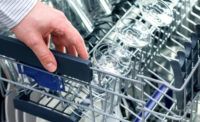The outlook for the home appliance market looks positive. Relatively better economies across global markets, with growth in the housing sector, including home refurbishments, growth in nuclear families, urbanization, improvement in lifestyle, and more disposable income amongst younger consumers are some of the key economic drivers of growth in the home appliance market.
Growth in adoption of connectivity technology, which has been backed by high adoption of smartphones, tech-savviness amongst consumer of various ages, familiarity with the touch controls mechanism, operating the world of mobile apps, introduction of the new voice-assistant technology, is also considered to be another driver of growth in the home appliance market. Even the fundamental reason for growth in adoption of connected appliances would be owning a relatively smart, intelligent and energy efficient appliance.
Furthermore, considering that white goods are high-energy-consumption devices, sometimes referred to as ‘power vampires,’ IHS Markit expects a shift towards energy efficient appliances to be one of the key drivers for the growth of the home appliance market across regions.
- First, there is a strong push from governments who are enforcing stringent energy and safety regulation legislations. As new energy-efficiency programs are being implemented in many regions across the world, particularly in North America and Europe, many appliances have to go back to the drawing board, re-engineering to meet minimum performance standards. Established efficiency programs continue to revise minimum requirements.
- Second, there is also a strong ‘pull’ from consumers who are demanding more energy-efficient appliances in order to combat higher utility bills.
- Third, appliance manufacturers wish to differentiate their products through innovation and adoption of new technologies aka invertorization which is a process through which appliances could be made more energy-efficient. And further falling component prices is also helping grow adoption of inverter technology.
The need to meet stricter energy and safety requirements, the desire to differentiate products, and falling component prices have all driven the use of electronics. One trend that is having a major impact on the electronic content of major home appliances, and especially the power semiconductor content, is the use of more advanced motor control, particularly inverter-based variable-speed control (also called variable frequency, VF control and VSD motors). There are a number of drivers of this trend, including:
Improving efficiency (hence reducing energy and even water consumption) of major home appliances in order to meet or exceed stringent regulatory standards and achieve higher ratings in markets with labeling schemes.
Reducing noise output from the appliance, especially those in kitchens, including dishwashers, refrigerators, washers and dryers.
Improving reliability. In previous years, many appliance designers were wary of using variable-speed control because they were concerned about the reliability of the “new” technology. However, as electronics design has been taken in-house by MHA makers and the technology has become more familiar, improved reliability can be realized through using VSD. This is mainly the result of the motors being optimized for various speed/torque combinations, thus running more efficiently and reducing wear.
Incentive-based stimulus programs by various government and legislative bodies and demand from consumers for more energy-efficient appliances have also led to growth in this market segment.
Global inverter-based home appliances witnessed a vigorous hike in 2016 after the Paris agreement in 2015. It is expected to maintain similar growth rates throughout 2021 as more and more consumers become aware of the impact of global warming. Confining the energy used in the residential sector translates to reducing energy consumption by home appliances, ideally without affecting their functionalities. Such savings are generally achieved by substituting technically more advanced equipment. With the new regulations in place, manufacturers are required to build products with higher energy standard, revised energy label and are obligated to provide those energy labels to their customers along with the product. This helps consumers to decide which appliances would be saving them more money and energy. The amount of saving is directly linked to the technology used in the appliance market.
The use of inverter-based technology is one of the most efficient ways to reduce energy consumption while increasing the appliance performance. The use of brushless Direct Current (DC) motor in combination with the advanced semiconductor components such as microcontrollers, Insulated Gated Bipolar Transistors (IGBTs) and Metal Oxide Semiconductor Field Effect Transistor (MOSFET) and other semiconductor ICs have opened new doors to technological advancement.
The use of inverter-based variable-speed control in appliances has continued to grow because of the reasons mentioned above. Based on IHS Markit’s Home Appliance Intelligence Service, the global penetration of inverter-based controlled or inverterized major home appliances is estimated to have been 37.3% in 2016. IHS Markit forecast that this will reach 64.4% in 2021, with each appliance types growing at varying pace depending upon the regulations and incentive plan by governments and appliance makers. The estimated penetration of inverter-based technology in 2016 was highest amongst room air-conditioners (56%) compared to dishwashers (50%), washing machines (43%), microwave ovens (28%), and refrigerators (20%). The size of the inverterized major home appliance market, including room air-conditioners, in terms of unit shipments estimated at 185 million units in 2016, is forecast to grow to 388 million units in 2021, registering a compound annual growth rate (CAGR) of around 16%.
Inverter-based technology and fabric care appliances
The inverter based technology of washing machines is also known as direct drive technology. It replaces the belt, pulley and the motor with the new Brushless DC motors attached directly to the shaft of the rotating drum. With this new configuration, the washing machine runs much cooler, makes less vibration, produces lower noise and uses less energy compared to the structure in the conventional washing machine. Because of less moving parts inverter designs allows longer lifespan, which is why manufacturers such as Haier, Samsung, LG, Whirlpool, Fisher & Paykel and many others are backing their inverter-based washing machine with over 10 years of motor warranty.
The global shipments of inverterized washing machine market is expected to grow from 50 million units in 2016 to 96 million units in 2021, registering a CAGR of around 14% during this period.
Inverter-based technology in cooling appliances
The most energy hungry component of any cooling appliance such as a refrigerator or a room air conditioner is its compressor unit. The inverter technology in the compressor unit allows the use of brushless DC motor along with advanced electronics and sensors. This combination allows intelligent control of power and running speed as per immediate cooling requirement. The sensor in the cooling compartment measures humidity and temperature at regular interval and adjusts the speed of the compressor accordingly. Inverter technology based fridges such as from Haier, AB Electrolux, Whirlpool and many others are capable of saving more than 30% of energy compared to their successors.
Inverterized cooling appliances like refrigerators and room air conditioners will in total grow from 102 million units in 2016 to 211 million units in 2021, showing a combined CAGR around 16% during this period.
Inverter-based technology in dishwashers
The inverter-based technology in dishwashers is not very different from the inverter-based technology of a washing machine. It also uses a brushless DC motor for the pump and the wash spray arms. The pressure of water jet from the pump can be adjusted through a microcontroller as needed. The brushless DC motor also aids in reducing the noise generated during operation.
The global shipments of inverter-based dishwasher market is expected to grow from nearly 14 million units in 2016 to 29 million units in 2021, registering a CAGR of around 18% during this period.
In a nutshell, inverter-based technology is the state of the art technology that allows major home appliances to be more efficient in energy, water and noise. When operated at recommended settings, these appliances can save about 60% of energy compared to conventional and inefficient models. It provides benefit to everyone as the manufacturers with the inverter technology have a higher price margin on energy efficient appliances compared to the conventional appliances and consumers can save on the utility bill and contribute to a greener environment.
The introduction of connectivity technology in home appliances is further contributing to this benefit as one can wirelessly connect and integrate the energy efficient appliances with the smart meter/smart grid though a connected thermostat, whereby consumers can automatically get to operate an appliance during that times of day where the unit prices of energy/electricity are lower. This creates a doubling benefit for the consumers—first the costs of running the energy efficient appliances is low (using less power), and second, running them at times when costs of electricity is low.




